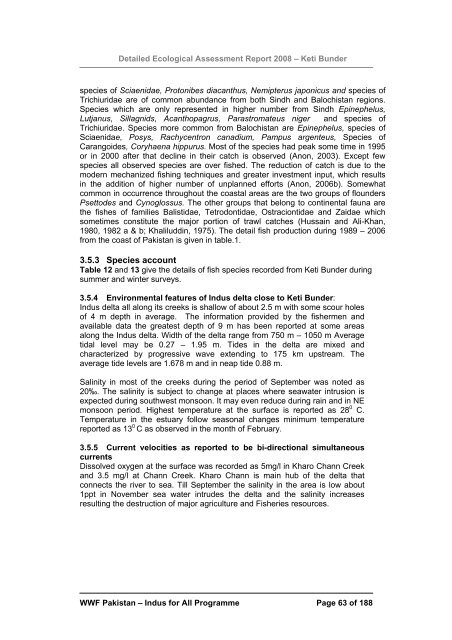Disclaimer note - WWF - Pakistan
Disclaimer note - WWF - Pakistan
Disclaimer note - WWF - Pakistan
You also want an ePaper? Increase the reach of your titles
YUMPU automatically turns print PDFs into web optimized ePapers that Google loves.
Detailed Ecological Assessment Report 2008 – Keti Bunder<br />
species of Sciaenidae, Protonibes diacanthus, Nemipterus japonicus and species of<br />
Trichiuridae are of common abundance from both Sindh and Balochistan regions.<br />
Species which are only represented in higher number from Sindh Epinephelus,<br />
Lutjanus, Sillagnids, Acanthopagrus, Parastromateus niger and species of<br />
Trichiuridae. Species more common from Balochistan are Epinephelus, species of<br />
Sciaenidae, Posys, Rachycentron canadium, Pampus argenteus, Species of<br />
Carangoides, Coryhaena hippurus. Most of the species had peak some time in 1995<br />
or in 2000 after that decline in their catch is observed (Anon, 2003). Except few<br />
species all observed species are over fished. The reduction of catch is due to the<br />
modern mechanized fishing techniques and greater investment input, which results<br />
in the addition of higher number of unplanned efforts (Anon, 2006b). Somewhat<br />
common in occurrence throughout the coastal areas are the two groups of flounders<br />
Psettodes and Cynoglossus. The other groups that belong to continental fauna are<br />
the fishes of families Balistidae, Tetrodontidae, Ostraciontidae and Zaidae which<br />
sometimes constitute the major portion of trawl catches (Hussain and Ali-Khan,<br />
1980, 1982 a & b; Khaliluddin, 1975). The detail fish production during 1989 – 2006<br />
from the coast of <strong>Pakistan</strong> is given in table.1.<br />
3.5.3 Species account<br />
Table 12 and 13 give the details of fish species recorded from Keti Bunder during<br />
summer and winter surveys.<br />
3.5.4 Environmental features of Indus delta close to Keti Bunder:<br />
Indus delta all along its creeks is shallow of about 2.5 m with some scour holes<br />
of 4 m depth in average. The information provided by the fishermen and<br />
available data the greatest depth of 9 m has been reported at some areas<br />
along the Indus delta. Width of the delta range from 750 m – 1050 m Average<br />
tidal level may be 0.27 – 1.95 m. Tides in the delta are mixed and<br />
characterized by progressive wave extending to 175 km upstream. The<br />
average tide levels are 1.678 m and in neap tide 0.88 m.<br />
Salinity in most of the creeks during the period of September was <strong>note</strong>d as<br />
20‰. The salinity is subject to change at places where seawater intrusion is<br />
expected during southwest monsoon. It may even reduce during rain and in NE<br />
monsoon period. Highest temperature at the surface is reported as 28 0 C.<br />
Temperature in the estuary follow seasonal changes minimum temperature<br />
reported as 13 0 C as observed in the month of February.<br />
3.5.5 Current velocities as reported to be bi-directional simultaneous<br />
currents<br />
Dissolved oxygen at the surface was recorded as 5mg/l in Kharo Chann Creek<br />
and 3.5 mg/l at Chann Creek. Kharo Chann is main hub of the delta that<br />
connects the river to sea. Till September the salinity in the area is low about<br />
1ppt in November sea water intrudes the delta and the salinity increases<br />
resulting the destruction of major agriculture and Fisheries resources.<br />
<strong>WWF</strong> <strong>Pakistan</strong> – Indus for All Programme Page 63 of 188

















